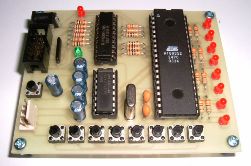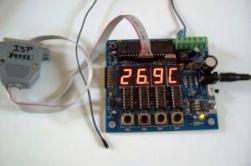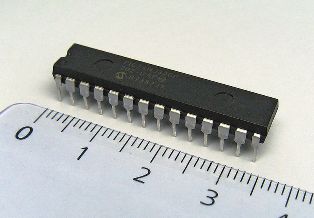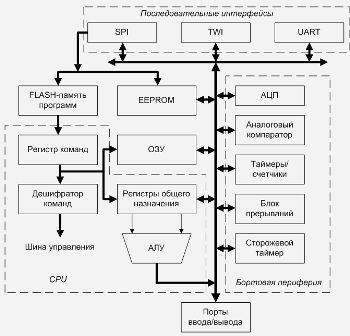Categories: Featured Articles » Home automation
Number of views: 189984
Comments on the article: 7
What are microcontrollers - purpose, device, software
 Microcontroller - This is a special chip designed to control various electronic devices. Microcontrollers first appeared in the same year as general-purpose microprocessors (1971).
Microcontroller - This is a special chip designed to control various electronic devices. Microcontrollers first appeared in the same year as general-purpose microprocessors (1971).
The microcontroller developers came up with an ingenious idea - to combine the processor, memory, ROM and peripherals inside one enclosure that looks like a regular microcircuit. Since then, the production of microcontrollers annually many times exceeds the production of processors, and the need for them has not decreased.
Microcontrollers are produced by dozens of companies, and not only modern 32-bit microcontrollers are produced, but also 16, and even 8-bit ones (like i8051 and analogues). Within each family, you can often find almost identical models that differ in CPU speed and memory size.
 The fact is that microcontrollers are mainly used in embedded systems, in toys, in machine tools, in mass home appliances, in home automation - where you need not processor power, but rather a balance between price and sufficient functionality.
The fact is that microcontrollers are mainly used in embedded systems, in toys, in machine tools, in mass home appliances, in home automation - where you need not processor power, but rather a balance between price and sufficient functionality.
That is why the oldest types of microcontrollers are still in use - they can do a lot: from automatically opening doors and turning on irrigation of lawns to integrating into smart home system. At the same time, there are more powerful microcontrollers that can perform hundreds of millions of operations per second and are tied with peripherals “to the teeth”. They have corresponding tasks. Thus, the developer first evaluates the task, and only then selects the appropriate hardware for it.
Today, there are more than 200 modifications of microcontrollers compatible with i8051, produced by two dozen companies, and a large number of other types of microcontrollers. Developers are popular with 8-bit PIC microcontrollers from Microchip Technology and AVR from Atmel, 16-bit MSP430 from TI, as well as 32-bit microcontrollers, ARM architecture, which is developed by ARM Limited and sells licenses to other companies for their production.

16-bit 28-pin PDIP PIC24 microcontroller

Microcontroller Atmel AVR ATmega8 in DIP package

Microcontroller device AVR
The microcontroller is characterized by a large number of parameters, since it is both a complex software-controlled device and an electronic device (microcircuit). The prefix "micro" in the name of the microcontroller means that it is performed using microelectronic technology.
During operation, the microcontroller reads commands from the memory or input port and executes them. What each command means is determined by the microcontroller command system. The command system is embedded in the architecture of the microcontroller and the execution of the command code is expressed in the performance of certain microoperations by the internal elements of the microcircuit.
Microcontrollers allow flexible control of various electronic and electrical devices. Some microcontroller models are so powerful that they can directly switch relays (for example, to Christmas garlands).
Microcontrollers, as a rule, do not work alone, but are soldered into a circuit where, in addition to it, screens, keyboard inputs, various sensors, etc. are connected.
Software for microcontrollers can attract the attention of those who love to “chase bits,” since the memory in microcontrollers usually ranges from 2 to 128 Kb. If less, then you have to write in assembler or Fort, if possible, use special versions of BASIC, Pascal, but mostly C. Before finally programming the microcontroller, it is tested in emulators - software or hardware.

The question may arise: is the microprocessor and microcontroller just a different name for the same device, or is it still different things?
A microprocessor is the central device of any computer, made by integrated technology. The name itself indicates that it is in it that computing processes occur. In order to make a computer out of it, even if it is not very modern and powerful (remember the amateur constructions of Radio 86 or Sinclair), it must be supplemented with external devices. First of all, it is RAM and input ports for outputting information.
The microcontroller has a processor, RAM, program memory, and in addition, a whole set of peripheral devices that turn the processor into a fully functional computer. According to the old terminology of the Soviet era, such devices were called single-chip Micro-computers. But Soviet computing, as you know, has reached a dead end, and with it OMEVM.
But foreign computer technology did not stand still, therefore OMEVM became known as controllers (from the English. Control - to manage, control). And in fact, the controllers turned out to be very suitable for controlling various equipment, even not very complicated.

The MICROCONTROLLER is no longer a processor, but also not a computer.
The central processor in each computer is the main computer. Although the computer is not intended solely for computational load, the processor is the head element in it. But not only the computer has a processor.
If you think about it and take a closer look, you can find that processors are used in most household appliances. Only there they use not such processors as in a computer, but microprocessors and even microcontrollers.
So what is a microcontroller and how is it different from the actual processor or are these completely different electronic components?
Large integrated circuits or integrated circuits are processors. Microprocessors are essentially the same processors, but because of the prefix “micro” their essence is determined that they are miniature than their “big” brothers. In its historical time, a processor with its size could occupy more than one room, it was just right to name them as extinct dinosaurs by macro-processors, in order to somehow arrange them in the modern idea of electronics.
Reduced in size and arranged processor takes up less space and can be placed in a more compact product, this is the microprocessor. But the processor itself can do little, except send data between the registers and perform some arithmetic and logical operations on them.
In order for the microprocessor to send data to the memory, this memory must either be present on the chip itself, on which the processor element itself is located, or connected to external RAM made in the form of a separate chip or module.
In addition to memory, the processor must interact with external devices - peripherals. Otherwise, what kind of benefit can be expected from the work of the processor, mixing and moving data back and forth. The point is when the processor interacts with I / O devices. On a computer, it is a keyboard, a mouse, and display devices as a display, optionally a printer and, for example, a scanner, again for entering information.
To control I / O devices, appropriate buffer circuits and elements are indispensable. Based on them, interface so-called hardware is implemented. Ways of interacting with interface elements require the presence of input / output port circuits, address decoders and bus formers with buffer circuits to increase the load capacity of the microprocessor.
Integration of the processor with all the necessary additional elements, so that this product poured into some kind of completed construct and leads to the formation of a microcontroller. A microcircuit or microcontroller chip implements a processor and interface circuits on a single chip.
A self-contained chip that contains almost everything, so that this is enough to build a finished product is an example of a typical microcontroller. For example, a wrist electronic clock or an alarm clock has a microcontroller inside, which implements all the functions of such a device. Individual peripheral devices are connected directly to the legs of the microcontroller microcircuit, or additional elements or microcircuits of small or medium degree of integration are shared.
Microcontrollers are widely used in products that contain the whole system exclusively in one miniature microcircuit, often called a microassembly. For example, a “chip” credit card contains a microcontroller inside in a plastic base. Intercom tablet also contains a microcontroller inside. And the examples of the use and application of microcontrollers are so extensive in the modern world that it is easy to detect the presence of a controller in any more or less intelligent device from a children's toy to a wireless cell phone headset.
See also at bgv.electricianexp.com
:
